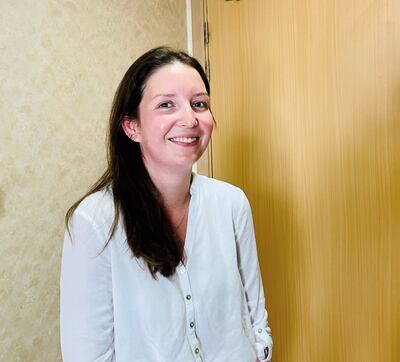A German cruise ship nurse who suffered from a rare and serious form of migraine has been released from hospital in Dubai.
Sophie Marie Troester, 27, was working on a cruise from Greece to Dubai, via Egypt and Jordan, when she was struck down by a crippling type of migraine that affects 0.01 per cent of people.
“It felt like a thunderstorm inside my head,” Ms Troester said.
"I was reading a book lying on my bed, and my vision started to blur. I understood that the migraine was kicking in, and I needed help. I had a previous experience."
She was experiencing the onset of a hemiplegic migraine. Signs of an attack are similar to what would be expected in a stroke.
Symptoms can include a sudden severe headache on one side of the head, weakness on one side of the body and problems walking, speaking and understanding. The effects can last for hours, days or weeks.
Fortunately, the cruise ship was docked on a short stopover in Dubai and Ms Troester was taken to hospital for urgent treatment after collapsing.
She has no family history of the condition, which struck on October 22.
“I tried to pick up my phone and ring my friend. My muscles had become weak. I could not hold the phone in my hand and it kept falling," she said.
“I had to try hard, and somehow, I managed to make a call. But all I could utter was a single word: hospital."
The attack caused her to collapse and she was rushed to Medeor Hospital, where doctors quickly diagnosed the condition and administered emergency treatment.
Severe attacks can cause permanent brain damage, or even death.
Ms Troester had suffered from mild migraines before, but this was the first time she lost control of the right side of her body, a symptom that often causes the condition to be misdiagnosed as a stroke.
Her last attack was in 2016 in Germany and although she was admitted to hospital, the episode was not diagnosed as a hemiplegic migraine.

Doctors told Ms Troester that she had suffered a migraine with aura, a condition in which the pain is caused by visual disturbances such as flashing lights.
“I used to get minor headaches, which lasted for a day or two. But one of this intensity had never happened," she said.
“A migraine hit me with tremendous pain. It felt like somebody was ripping my head apart.
“This excruciating pain continued for a few minutes, followed by weaknesses in the muscle."
She said her migraines usually subsided after an hour and any lasting effects were gone within a couple of days.
“Then everything is fine and feels like normal," she said.
Hemiplegic migraine symptoms often start in childhood or teenage years, and can disappear in adults.
Researchers have linked four genes with the condition: CACNA1A, ATP1A2, SCN1A and PRRT2.
Defects, or mutations, in any of these genes can interrupt communication between certain nerve cells, leading to severe headaches.
A child has a 50 per cent of inheriting the condition from a parent.
Ms Troester was treated by Dr Anas Abdul Majeed, a consultant neurologist at Medeor Hospital, who said migraines affected about 15 per cent of the population.
Be he was surprised to see a patient with such a rare and extreme form of migraine.
“She had the sequential pattern, which helped in the diagnosis,” he said.
“The hallmark of hemiplegic migraine is one-sided weakness accompanied by a migraine attack.
“It begins with a visual symptom followed successively by abnormal sensation, muscle weaknesses and difficulty in speaking.
“Each symptom evolves over 20 to 30 minutes and may take hours to subside.”
Ms Troester has fully recovered and can return to regular life, but she must now take medication to avoid further attacks.
Dr Majeed said the condition could be difficult to identify because symptoms were similar to those of a stroke.
“Proper diagnosis is crucial and [can be] challenging as it is purely a clinical process unaided by imaging and other tests," he said.







